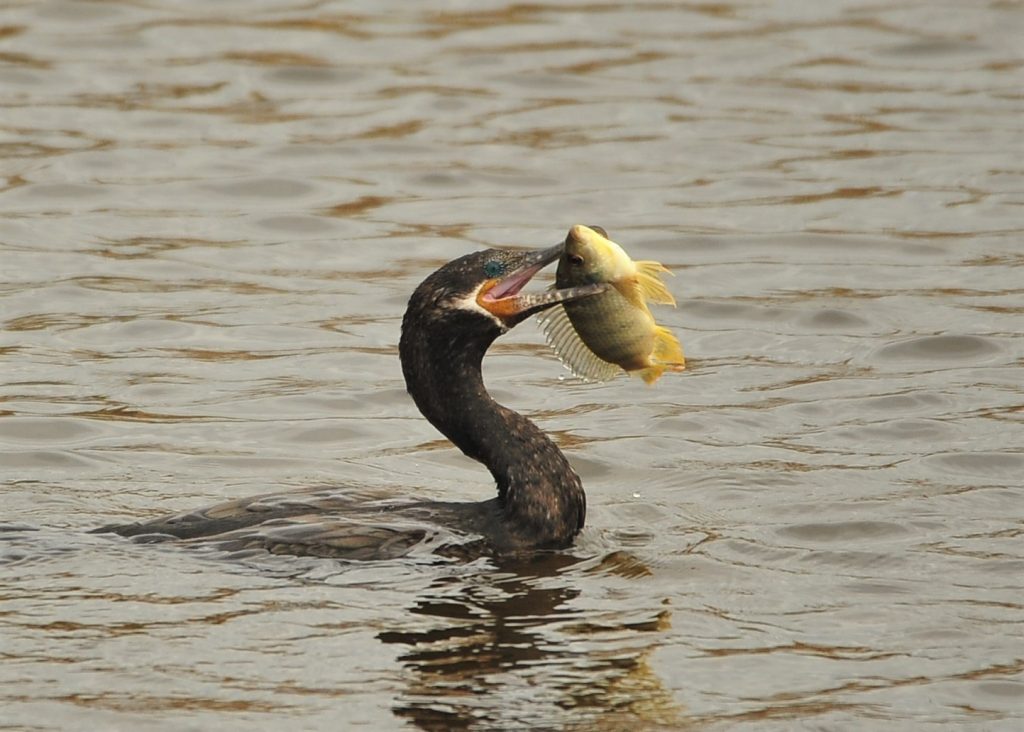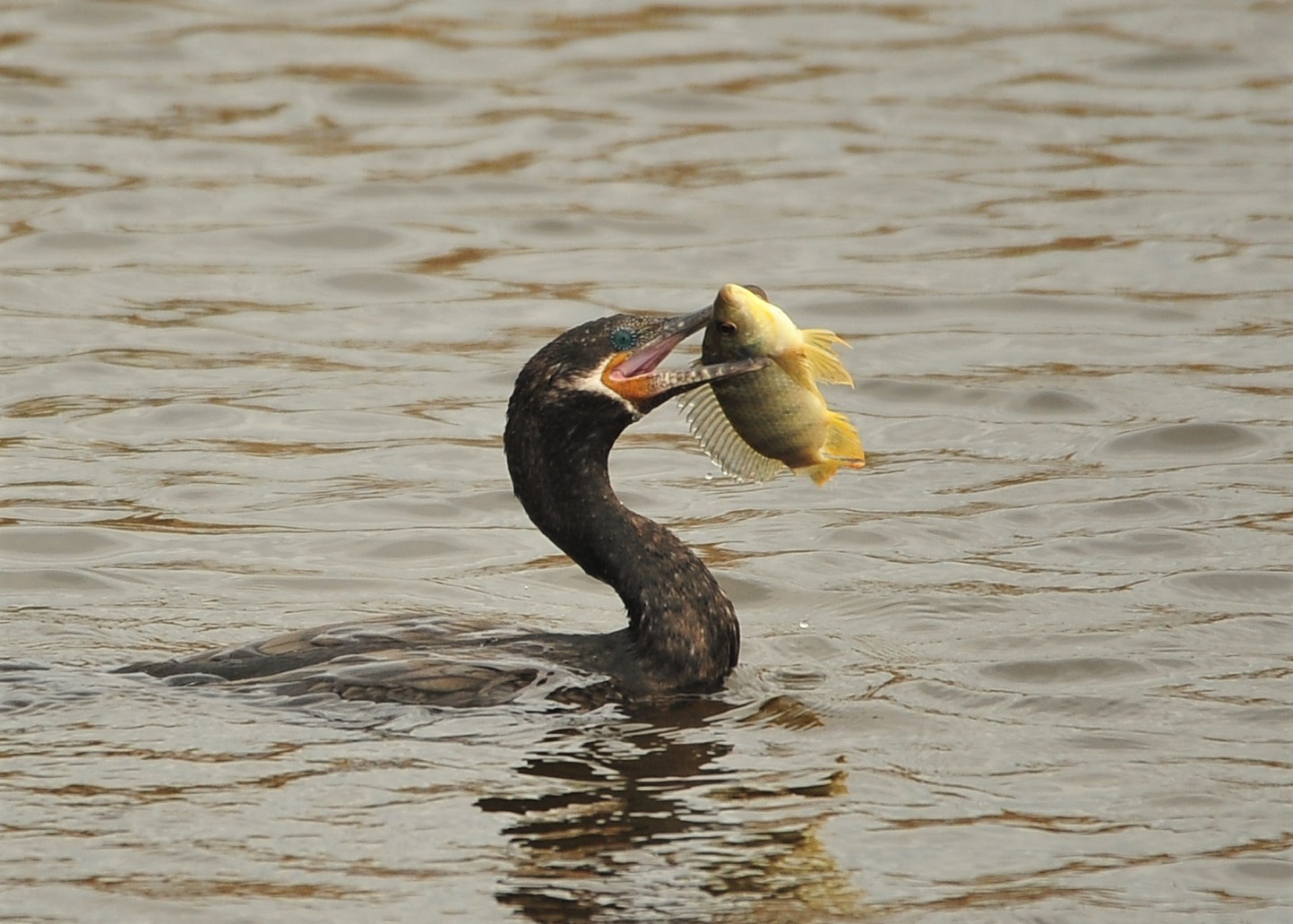by M. Kathy Raines

“Diving ducks!” we cried as sleek, streamlined black cormorants seamlessly slipped beneath resaca waters behind our Brownsville apartment complex. Moving from Indiana in the ‘80s to teach school, we had never seen the like.
An efficient hunter, our native Neotropic cormorant—with its round, emerald eyes and long, uplifted, hooked bill—has the demeanor of a grim schoolmaster. I would never crack a joke in its presence. In fact, in John Milton’s epic poem “Paradise Lost”, a cormorant, serving as one incarnation of Lucifer, perches on the Tree of Life to spy upon Adam and Eve.
Neotropic cormorants, often in concert with wintering double-crested cormorants, create striking sculptures along bare branches, many of the birds drying outspread wings. While our local, smaller species wears a light-yellow gular (throat) patch, bordered with white, the double-crested has an orange patch. The neotropic cormorant has a grayish bill and an olive sheen to its feathers. A patch of slender feathers along its head, sides and back give a breeding adult a streaky appearance.
The forty or so species of cormorants—in the family Phalacrocoracidae (Greek for “bald raven”)—have dark feathers, hooked bills, lengthy necks, wedged tails and visible facial skin and throat pouches. Also, their legs, which sit well behind their bodies, give them a waddling gait. They emit a low, frog-like croak or grunt to ward off intruders, earning them the nickname “pig duck” (pato cerdo), along with “sea crow” and “water turkey.” “Cormorant” may be a contraction of the Latin “corvus marinus”. According to ornithologist David Allen Sibley, a cormorant catches “more fish per unit of effort, on average, than any other animal.”
The neotropic cormorant (Phalacrocorax brasilianus) breeds along mainly southern resacas, lakes and ponds in the United States, especially along the Gulf, but sometimes as far inland as Dallas. This cormorant, with wings closed, dives from the surface and swims, employing its feet as propellers, in pursuit of fish, frogs, crustaceans and aquatic insects. In fast streams, it may hunt in groups of from three to eight, beating the water with its wings to drive fish from the shallows for easy capture. Occasionally, it carries a sizeable fish shoreward to beat and subdue. Unlike others of its genus, the neotropic cormorant may plunge dive, wings folded, into breaking waves or calm waters after schools of fish.
This skilled hunter emerges from water every 20 minutes or so after the water’s weight reaches about six percent of the cormorant’s weight. Then it spreads its wings to dry. Parts of a cormorant’s feathers are water resistant, but other sections do become soaked—thus decreasing buoyancy and enabling it to swim efficiently underwater.
Year-round colonial breeders, thousands of grunting cormorants periodically converge along branches near the resaca at Gladys Porter Zoo and nearby Dean Porter Park, forming a metropolis of squabbling, but mainly convivial birds, each toting sticks to one of the tree’s multiple nests. Monogamous during breeding times, a male selects a site, possibly the previous year’s, and creates displays, hoping to entice a mate. He may do wing-waving, wherein he calls to a female, wingtips raised, or he may fly towards her, waving his neck and head. Both males and females engage in gaping, in which, heads swaying slowly, and necks stretched upward, they vocalize and open their mouths to reveal inner linings. The female lays up to five bluish white eggs, which both birds incubate and feed. Young swim and dive at eight weeks, gaining independence at twelve.
This cormorant, with its short, rounded wings, flies powerfully and continuously, low over water and higher over land. Flocks may fly in a line or V-shape. Landing with its tail fanned, it brakes with its outspread feet. In a strong lift-off, it runs on the water’s surface, beating with its feet and flapping wings to gain speed.
Throughout history, various peoples have used cormorants, as one employs a falcon, for catching fish. A loose snare at the base of the bird’s throat stops it from swallowing all but the smallest fish. The Peruvian Uro people, native to floating islands in Lake Titicaca, fish with the neotropic cormorant. Elsewhere, though, people engage in this practice mainly for the amusement of tourists.
Suspecting cormorants of theft, some anglers and hatchery workers shoot them, although the birds enjoy federal protection. Generally tolerant of human behavior, a disturbed cormorant may abandon its nest, leaving eggs vulnerable to opportunists like great-tailed grackles. Abundant in southern coastlands down through most of South America, the neotropic cormorant appears to be expanding northward.


Leave a Reply